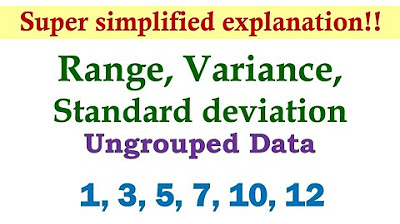Range, variance and standard deviation as measures of dispersion | Khan Academy
TLDRThis educational video script discusses the concept of central tendency and introduces measures of dispersion to understand the spread of data sets. It compares two data sets with the same mean but different levels of dispersion, illustrating the concepts of range, variance, and standard deviation. The script explains how to calculate these measures, highlighting that while the range is a simple measure, variance and standard deviation provide a more nuanced understanding of data spread. The video aims to clarify the difference between population and sample measures, emphasizing the importance of dispersion in statistical analysis.
Takeaways
- 📊 The video discusses different methods to measure the spread or dispersion of a dataset, in addition to central tendency.
- 🔢 Two example datasets are provided to illustrate the concepts: one with values -10, 0, 10, 20, 30 and another with 8, 9, 10, 11, 12.
- 🧮 The arithmetic mean (population mean) is calculated for both datasets, which turns out to be 10 for each, showing that means alone do not reflect the spread of data.
- 📈 The concept of dispersion is introduced, highlighting that a dataset can have the same mean but different spreads, affecting the interpretation of the data.
- 🚀 The range is mentioned as a simple measure of dispersion, calculated as the difference between the maximum and minimum values in a dataset.
- 📊 The range for the first dataset is 40 (30 - (-10)), and for the second, it is 4 (12 - 8), indicating the first dataset is more spread out.
- 📘 Variance is introduced as a more commonly used measure of dispersion than the range, calculated using the squared differences from the mean.
- 🔍 The formula for variance is explained as the average of the squared differences between each data point and the mean.
- 📊 Variance is calculated for both datasets, resulting in 200 for the first and 2 for the second, showing the first dataset is significantly more dispersed.
- 📏 The standard deviation is introduced as the square root of the variance, providing a measure of dispersion in the same units as the data.
- 📐 The standard deviation for the first dataset is approximately 14.14 (square root of 200), and for the second, it is about 1.41 (square root of 2), emphasizing the difference in dispersion.
- 📚 The video concludes by emphasizing the importance of understanding both the mean and standard deviation to fully comprehend a dataset's characteristics.
Q & A
What is the main topic discussed in the video?
-The main topic discussed in the video is the concept of central tendency and measures of dispersion in statistics, specifically focusing on how spread apart data is in a dataset.
What are the two datasets provided in the video to illustrate the concept of dispersion?
-The two datasets provided are: -1, 0, 10, 20, 30 and 8, 9, 10, 11, 12.
How is the arithmetic mean calculated for both datasets in the video?
-The arithmetic mean is calculated by summing all the numbers in the dataset and then dividing by the total number of data points. For both datasets, the sum is 50 and there are 5 data points, so the mean is 50/5 = 10.
What is the difference between a population and a sample in the context of statistics?
-In statistics, a population refers to the entire set of data points that one is interested in studying, while a sample is a subset of the population that is used to make inferences about the entire population.
What is the range of the first dataset mentioned in the video?
-The range of the first dataset (-1, 0, 10, 20, 30) is calculated by subtracting the smallest number from the largest number, which is 30 - (-10) = 40.
How is the variance calculated for a dataset?
-The variance is calculated by taking the difference between each data point and the mean, squaring these differences, summing them up, and then dividing by the number of data points.
What is the variance of the first dataset in the video?
-The variance of the first dataset (-1, 0, 10, 20, 30) with a mean of 10 is calculated as (400 + 100 + 0 + 100 + 400) / 5 = 1000 / 5 = 200.
What is the standard deviation and how is it related to variance?
-The standard deviation is a measure that indicates the average distance of each data point from the mean. It is the square root of the variance and is used to express the dispersion of data in the same units as the data points.
What is the standard deviation of the first dataset in the video?
-The standard deviation of the first dataset is the square root of the variance, which is √200. This can be simplified to 10√2.
Why might the units of variance be considered 'odd' and what is the advantage of using standard deviation instead?
-The units of variance can be considered 'odd' because they are squared units of the original data, which might not be intuitive or meaningful in certain contexts. The standard deviation has the same units as the original data, making it easier to interpret and compare.
How does the video illustrate the difference in dispersion between the two datasets?
-The video illustrates the difference in dispersion by comparing the range and variance of the two datasets. The first dataset has a larger range (40) and variance (200), indicating greater dispersion compared to the second dataset with a smaller range (4) and variance (2).
Outlines
📊 Understanding Data Dispersion and Mean
The video begins by revisiting the concept of central tendency, specifically the mean, and then transitions into discussing data dispersion. Two data sets are introduced: one with values -10, 0, 10, 20, 30 and another with 8, 9, 10, 11, 12, both having the same mean of 10. The presenter emphasizes that while the means are identical, the data points in each set are spread differently from the mean, illustrating the concept that dispersion is an important aspect of data analysis. The range, calculated as the difference between the maximum and minimum values in a data set, is introduced as a simple measure of dispersion. However, its limitations are acknowledged, as it does not account for the distribution of all data points.
📈 Calculating Variance to Measure Dispersion
This section delves into a more sophisticated measure of dispersion called variance. The process involves subtracting the mean from each data point, squaring the result, and then averaging these squared differences. Using the first data set as an example, the presenter calculates the variance to be 200. This is contrasted with the second data set, which has a variance of only 2, indicating it is less dispersed. The explanation clarifies that variance provides a measure of how spread out the numbers in a data set are from the mean, with a higher variance indicating greater dispersion.
📉 Introducing Standard Deviation for Dispersion Insight
The final part of the script introduces standard deviation, which is the square root of the variance, as a way to express dispersion in a more intuitive and unit-consistent manner. The standard deviation is calculated for both data sets: the first with a variance of 200 has a standard deviation of 10√2, and the second with a variance of 2 has a standard deviation of √2. The presenter highlights that the first data set has 10 times the standard deviation of the second, providing a clear and practical sense of the dispersion in each set. The standard deviation is emphasized as a valuable tool for understanding the average distance data points are from the mean, offering a more relatable measure of dispersion than variance alone.
Mindmap
Keywords
💡Central Tendency
💡Arithmetic Mean
💡Population Mean
💡Measures of Dispersion
💡Range
💡Variance
💡Standard Deviation
💡Squared Differences
💡Dispersion
💡Data Set
Highlights
Introduction to the concept of measuring data spread or dispersion in addition to central tendency.
Explanation of the arithmetic mean calculation for two different data sets.
Understanding the difference between population and sample means in statistics.
Illustration of how two data sets can have the same mean but different spreads.
Introduction to the concept of range as a simple measure of dispersion.
Calculation of range for two example data sets to show differences in spread.
Limitations of range as a measure of dispersion due to its sensitivity to outliers.
Introduction to variance as a more commonly used measure of dispersion.
Explanation of the formula and calculation process for population variance.
Demonstration of variance calculation for a data set with a wider spread.
Comparison of variances between two data sets to illustrate differences in dispersion.
Introduction to standard deviation as the square root of variance.
Calculation of standard deviation for both data sets to compare dispersion.
Discussion on the practicality of standard deviation over variance due to unit consistency.
Intuitive understanding of standard deviation as a measure of average distance from the mean.
Summary of the importance of standard deviation in understanding data spread.
Transcripts
Browse More Related Video

Measures of Dispersion (Ungrouped Data) | Basic Statistics

Statistics: Standard deviation | Descriptive statistics | Probability and Statistics | Khan Academy

Descriptive Statistics: FULL Tutorial - Mean, Median, Mode, Variance & SD (With Examples)

Measures of Variability (Range, Standard Deviation, Variance)

Understanding Standard deviation and other measures of spread in statistics

Descriptive Statistics [Simply explained]
5.0 / 5 (0 votes)
Thanks for rating: